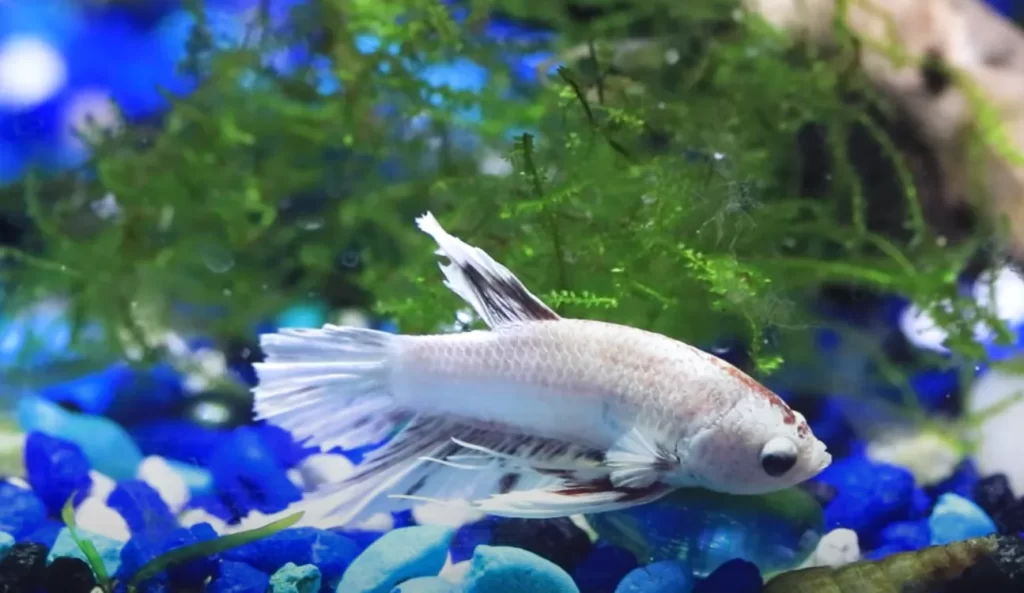How Often Do Bettas Come Up for Air?
We embark on an underwater adventure to explore the captivating world of bettas and their extraordinary breathing behavior. These vibrant and graceful creatures, also known as Siamese fighting fish, have fascinated aquarium enthusiasts for centuries. While we admire their stunning colors and elegant fins, it’s crucial to understand their unique respiration needs.
In this blog post, we’ll delve into the intriguing question of how often bettas come up for air. By gaining insights into their breathing habits, we can ensure their well-being and create a thriving environment for these enchanting aquatic gems.
So, grab your snorkels and get ready to uncover the secrets of betta fish respiration!

Overview of betta fish and their unique respiratory system
Betta fish, also known as Siamese fighting fish, are unique creatures with a fascinating respiratory system. Unlike most fish, bettas have a labyrinth organ, which allows them to breathe air from the surface. This adaptation enables them to survive in low oxygen conditions and thrive in environments that other fish may struggle with.
The labyrinth organ, located in the gills of betta fish, acts as an extra respiratory system. It enables them to extract oxygen directly from the air, in addition to the oxygen obtained through their gills. This ability gives bettas an advantage in environments with limited oxygen supply.
Due to their unique respiratory system, betta fish have a habit of coming up to the water surface to breathe air. This behavior becomes more frequent when the oxygen levels in the water are low. It is their way of ensuring they get enough oxygen to survive and maintain their activity levels.
While bettas can survive in small bowls, it is recommended to provide them with a larger tank with proper aeration. A larger tank provides more oxygen for the fish, reducing the frequency of coming up for air. A well-aerated tank with a filtration system improves the overall well-being of the fish and promotes a healthier environment.
The frequency of betta fish coming up for air varies based on individual fish and their surroundings. Active bettas may come up for air more frequently, while less active ones may take longer breaks between breaths. Environmental factors, such as water temperature, oxygen levels, and the presence of other fish, can also influence their breathing patterns.
Understanding Betta Fish Respiration
Explanation of how bettas breathe and their need for access to the water’s surface.
Betta fish are unique creatures that have a specialized labyrinth organ, enabling them to breathe air from the water’s surface. Unlike most fish, bettas can survive in low-oxygen environments, but they still need access to the water’s surface to replenish oxygen. They come up for air regularly, taking in gulps of atmospheric oxygen to supplement what they obtain through their gills. So, if you have a betta fish, make sure they have easy access to the water’s surface to ensure their respiration needs are met.
Factors Affecting Betta Fish Respiration
Discussion on various factors that can influence how often bettas come up for air, including water temperature, oxygen levels, and stress
Betta fish, also known as Siamese fighting fish, have a unique breathing method that allows them to breathe oxygen from both air and water. However, several factors can influence how often bettas come up for air.
The water temperature plays a significant role in their respiration rate. Bettas are tropical fish and prefer warmer water between 78-80°F (25-27°C). In colder temperatures, their metabolism slows down, and they may come up for air less frequently.
The oxygen levels in the water are crucial for bettas’ respiration. Poor water quality with low oxygen levels can force them to come up for air more often. It is important to maintain a well-aerated aquarium with proper filtration and regular water changes.
Stress can also affect bettas’ respiration patterns. Factors like overcrowding, aggressive tank mates, or sudden changes in water conditions can cause stress and lead to increased respiration rates. Providing a stress-free environment with appropriate hiding spaces and a balanced tank environment is essential for their well-being.
Normal Breathing Behavior of Bettas
When it comes to breathing, bettas have a unique adaptation that allows them to take in oxygen from the air. They have a specialized organ called the labyrinth organ that enables them to breathe atmospheric air. Unlike other fish species that rely solely on gills to extract oxygen from water, bettas are capable of taking breaths from the surface.
Typically, bettas will come up to the water’s surface to take in air every 15 to 30 minutes. This behavior is perfectly normal and should not be a cause for concern. However, the frequency may vary depending on factors such as water temperature, quality, and stress levels. It is important to provide bettas with access to fresh air by leaving a small gap between the water’s surface and the tank lid.

There are some instances where bettas may come up to the surface more frequently than usual. This could be a sign of inadequate oxygen levels in the water or a potential health issue. If you notice your betta gasping for air excessively or struggling to breathe, it is essential to evaluate the water conditions and seek professional advice if necessary.
Related Post: Betta Fish Injured: Causes and Treatment
Common Misconceptions about Betta Fish Respiration
As Betta fish are often kept in small fish bowls or vases, many people wonder how often they come up for air. It is a common misconception that Betta fish need to breathe atmospheric air frequently. However, this is not entirely accurate.
Debunking myths and misconceptions about bettas’ need for air and their ability to breathe outside of water
Contrary to popular belief, Betta fish do not need to come up for air as often as many people think. While they do possess a specialized organ called the labyrinth organ, which allows them to breathe atmospheric air, Betta fish are mainly adapted to extract oxygen from water. In fact, they can extract oxygen from water through both their lungs and gills.
Many Betta fish enthusiasts and experts recommend using a filtration system in their tanks to ensure a constant supply of oxygen in the water. This helps them thrive and reduces the need for them to come up to the water’s surface for air. It is important to provide a well-maintained and oxygen-rich environment for Betta fish to ensure their overall health and well-being.
Understanding the true needs of Betta fish regarding respiration helps dispel misconceptions and allows pet owners to provide the best care possible for these beautiful creatures.
Providing Adequate Oxygen for Bettas
Tips and techniques for ensuring your betta has access to enough oxygen, including proper tank setup, filtration, and water quality
Bettas are beautiful and fascinating fish, and providing them with adequate oxygen is crucial for their health and well-being. Here are some tips to ensure that your betta always has access to enough oxygen:
- Proper Tank Setup: Bettas require a tank with enough surface area for oxygen exchange. A tank that is too small or overcrowded can limit the oxygen available to your fish. Aim for a tank size of at least 2.5 gallons, with an open top for efficient gas exchange.
- Good Filtration: A well-functioning filter can help to oxygenate the water in your betta’s tank. Choose a filter with a gentle flow, as bettas prefer calm waters. Regularly clean and maintain the filter to ensure its effectiveness.
- Water Quality: Poor water quality can reduce the oxygen content in your betta’s tank. Regularly test the water parameters and perform partial water changes to maintain optimal conditions. Avoid overfeeding your betta, as excessive waste can impact water quality.
By implementing these tips and techniques, you can ensure that your betta has access to enough oxygen to thrive. Remember to monitor your betta’s behavior and make adjustments as needed. With proper care, your betta will flourish in its oxygen-rich environment.

Signs of Respiratory Distress in Bettas
If you’re a betta fish owner, you may be wondering how often these beautiful creatures come up for air. Bettas are air-breathing fish and have a special organ called a labyrinth organ that allows them to breathe atmospheric oxygen. While they primarily breathe through their gills, they do occasionally come up to the water’s surface to take a gulp of air.
If you notice any signs of respiratory distress in your betta, it’s important to act quickly. Symptoms of respiratory problems may include gasping, rapid gill movement, lethargy, or struggling to reach the surface for air.
If your betta shows any of these signs, it’s recommended to seek veterinary care. A veterinarian who specializes in fish health can help diagnose the problem and provide appropriate treatment options. Remember, early intervention is key to ensuring the health and well-being of your betta fish.
Regular maintenance of your betta’s tank can also help promote good respiratory health. Ensure that the water quality is optimal, with proper filtration and regular water changes. Avoid overcrowding the tank and provide ample aeration to keep the oxygen levels in the water balanced.
By monitoring your betta for any signs of respiratory distress and providing a clean and healthy environment, you can help ensure that your betta has the best possible chance of staying healthy and thriving.
Frequently Asked Questions
Betta fish are known for their unique breathing habits, which often involve them coming up to the surface of the water for air. Here are some answers to commonly asked questions about bettas and their breathing needs:
How often do bettas come up for air?
Betta fish are labyrinth breathers, meaning they have a specialized organ called a labyrinth organ that allows them to breathe air. They usually come up to the surface every 10-15 minutes to take a breath.
Can bettas survive without coming up for air?
While bettas have the ability to breathe air, they still require their gills to extract oxygen from the water. They should have access to both air and water to thrive and survive.
What should I do if my betta is not coming up for air?
If your betta is not coming up for air, it could be a sign of a problem. Check the water temperature, quality, and ensure that there is enough oxygenation in the tank. If the issue persists, it is best to consult a veterinarian who specializes in fish care.
Conclusion
Betta fish are labyrinth fish, which means they have the unique ability to breathe oxygen from the air. While they have gills and can extract oxygen from water, they also need to come up to the water’s surface to breathe air. This behavior is essential for their survival, as they need both oxygen from the water and the air to meet their respiratory needs.
To ensure the health and well-being of your betta fish, it is crucial to provide them with optimal conditions for respiration. This includes maintaining clean water with proper temperature and filtration, ensuring they have access to the water’s surface, and avoiding overcrowding in their tank.
By understanding the natural behavior of betta fish and providing a suitable environment, you can help them thrive and enjoy their unique respiratory abilities. Remember to monitor their behavior and health regularly and make any necessary adjustments to their habitat to ensure their well-being.
Related Posts:





